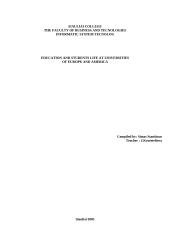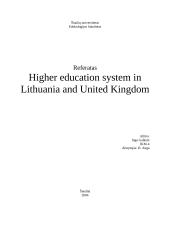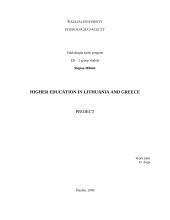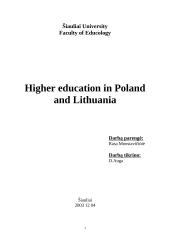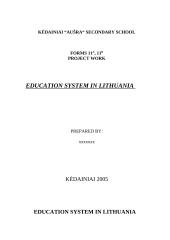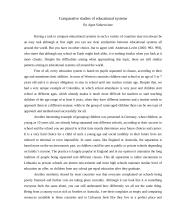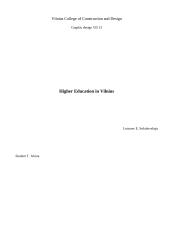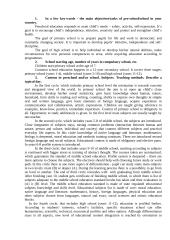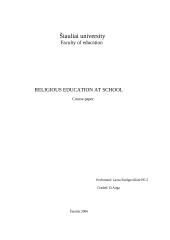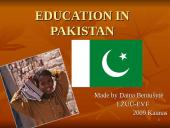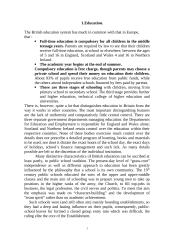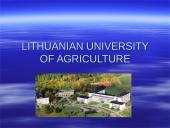Referatai
Primary education in Lithuania and United States of America (USA)
Šiauliai university Faculty of education Primary education in Lithuania and USA Course paper Performed: Laura Smilgevičiūtė PE-5 Graded: D.Auga Šiauliai 2006 Like every country has the laws, of course it has and educational system too, which lets pupils, students of various age groups to aspire knowledge. There is no similar teaching structure in each country, because different countries have different values, which they want to give for their children. And to my mind, the most important educational time is primary education, because it is the time, then child's personality is just growing and primary teaching influences the further developing . I have chosen to talk in my work about primary education in Lithuania and United States, because i wanted to discuss the main thing of this educational system, to hunt out differences and similarities of primary teaching among little European country and western giant. First of all, i will try to discuss primary education of Lithuania, the basic traits: it would be school year time, allotment into classes, all primary assessment, subjects of teaching, discribing a little bit what do the children are learning. Likewise i will talk about primary education in United States, also discribing assessment, school year time, teaching subjects and etc. Lastly, i will try not only to talk over the each system, but also to compare elementary education in Lithuania and United States, in addition to see what have both countries in their education system, and what disjunct, in order to see, maybe it is need to replace something in primary education structure in our country. Maybe my course paper will help to find out what primary education is the best for our young people, to find better way of learning, teaching in the first years of studying. Primary education in Lithuania "In the past education in Lithuania was closely linked with the spread of Christianity. It was under the auspices of the Church that the first school was set up in Lithuania at the end of the 16th century. In independent Lithuania (1918 - 1940) compulsory primary education was introduced in 1927 - 1930. In 1940, there were 2943 primary schools " (2) Nowadays primary education in the Lithuania is still compulsory and free, except for private schools. Parents can enrol their children in the school of their choice. Duration is four years, it means there are 1 - 4 form. In different schools primary education is slightly unlike, but of course there are base standard of this education structure. According to the law on education, a child starts attending the first form of primary education in the calendar year when he turns seven years of age. But with parents request, primary education may begin before the time specified above if the child has achieved the maturity required for this kind of education. It means, that pupils can start learning at six years old. Timetable in primary schools is five days per week, from monday to friday , except for legal holiday, which are November 1th , February 16 th , March 11 th etc. School year starts on september 1 st. Children have four basic holidays, which are summer - from end of june to september 1 st , autumn - a week in the beginning of November, Christmas holidays - two weeks, and Easter holidays - one week. Also there are additional holidays two weeks (schools may choose the time). The lessons start at 8.30 a.m. in some schools at 8.00 a.m. and finish approximately at 12 p.m. The duration of a regular lesson in the first year of primary education last thirty five minutes, and in the later forms - forty five minutes. Children may additionally attend extra-curriculum activities that are organized at school, after the lessons are finished.(sar) To talk about class size norms in primary schools of Lithuania, a maximum is of twenty five to thirty six pupils in one class, and classes are divided into A, B, C and etc. according of number of pupils. Of course in district's schools there are less children. In primary schools all subjects are compulsory and are the same for all pupils. There are one teacher, who teaches all subjects. Most teachers and parents think, that pupils at first have to learn to write, to read and to count simply. However parents suggest one more task to pupil - to start learning foreign language at early form. Early foreign language teaching starts in the second form. At form 4, learning of a foreign language is compulsory for all. "The purpose of primary education is to provide an individual with the basic of moral, cultural and social maturity and elementary litracy". (10) So the primary education curriculum comprises languages (mother tongue, foreign language), moral (basics of religion and ethics), social and natural sciences (perception of the world), mathematics, arts (visual art, music, theatre, and choreography), technology (crafts), health (physical training) education. Teaching languages at first pupils learn alphabet, spelling syllables and collocate. To write letters, words. To read. In higher forms pupils learn to read simply literacy, to write dictations. In foreign languages they are under training to memorize words, to write them and etc. Moral education, if it is religious, teach to know God, to learn ten god's diktate and generally religious education purpose to ready pupils for firt eucharist. Ethics teach to know what is respect, love, hate and etc. Natural sciences let pupils to explore surrounding, world. Supervising nature children tell what new did they understand and learn. For example, reading or wathing pictures about bees pupils realize what is their purpose. Mathematics teach children to count simply, sometimes including vizual training aids (sticks, verbal exercises etc.) Pupils draw, do simple appliques in art lessons. They are teached to use gouache, watercoluor, plasticine and other material. In choreography lessons children are teached flexibility, grace. Physical training is very necessary for pupi'ls health, so children have some lessons to learn to play "quadrate" and other simply sports. " Teachers are free to use the teaching methods and textbooks of their choise from a list approved by the ministry of education and science".(10). For that reason, most teachers choose simple explanation system, often without visual training aids and games, which are very necessary for young child. " The "method of game" can be used in the primary classes on purpose better results. The concept of the game method is used, then it is talking about using a game in a certain lesson according the theme of that lesson. It means, that the game is organised in order to deepen check and deliver the knowledge."(3) Teachers aren't taking part in this activity becouse this teaching method won't give good result, as game in the lessons would be like fun, but not a lesson. The questionnaire, which were made in some Lithuania schools show, that pupil's parents think differently than teachers. 52,4% think that games should be played once a day, 4,8% - every day, 42,8% - once per week1pic. . But for the present, just some teachers in Lithuania primary schools applies this method to capture the attention of pupils. Primary school children in Lithuania are not given grades. Pupils knowledge, skills, capibilities, endeavour assessment is not a grade, but gains descriptions. Children are continuosly assessed by their teachers, but at last two or three times per year the teacher discuses the progress of learners communicated with pupil's parents. Child's knowledge is described in " Attainment book". To understand child his assessment, teacher draw different pictures. For example, smiling sunny means very good, sad cloud - bed and etc. Every teacher choose pictures by his option discretion. " Pupils in difficulty can be made to repeat a year. At the end of primary school, pupils automatically move on to the next level without a final examination".(10) Primary education in United States "The first schools in most cities, towns and frontier settlements all across America were oneroom schoolhouses. Many were built about 150 years ago, between 1820 and 1840. At that time a new generation of Americans was growing up. Many people were concerned about who would be responsible for taking care of these large nubers of children.
Šį darbą sudaro 3291 žodžiai, tikrai rasi tai, ko ieškai!
★ Klientai rekomenduoja
Šį rašto darbą rekomenduoja mūsų klientai. Ką tai reiškia?
Mūsų svetainėje pateikiama dešimtys tūkstančių skirtingų rašto darbų, kuriuos įkėlė daugybė moksleivių ir studentų su skirtingais gabumais. Būtent šis rašto darbas yra patikrintas specialistų ir rekomenduojamas kitų klientų, kurie po atsisiuntimo įvertino šį mokslo darbą teigiamai. Todėl galite būti tikri, kad šis pasirinkimas geriausias!
Norint atsisiųsti šį darbą spausk ☞ Peržiūrėti darbą mygtuką!
- Mokslo ir švietimo referatas
- 12 psl., (3291 ž.)
- Word failas 112 KB
- Lygis: Universitetinis
- ✅ Yra šaltiniai
Mūsų mokslo darbų bazėje yra daugybė įvairių mokslo darbų, todėl tikrai atrasi sau tinkamą!
Panašūs darbai
Privalumai
Atsisiuntei rašto darbą ir neradai jame reikalingos informacijos? Pakeisime jį kitu nemokamai.
Pirkdamas daugiau nei vieną darbą, nuo sekančių darbų gausi 25% nuolaidą.
Išsirink norimus rašto darbus ir gauk juos akimirksniu po sėkmingo apmokėjimo!
Atsiliepimai


















